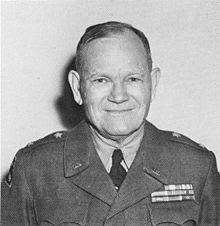Lieutenant General Frank William Milburn (January 11, 1892 – October 25, 1962) was a senior United States Army officer who served during World War II and the Korean War. From December 1943, through the end of World War II, Milburn commanded the XXI Corps (United States).
Frank William Milburn | |
|---|---|
 | |
| Nickname(s) | "Shrimp"[1] |
| Born | January 11, 1892 Jasper, Indiana, United States |
| Died | October 25, 1962 (aged 70) Missoula, Montana, United States |
| Allegiance | |
| Service | |
| Years of service | 1914–1952 |
| Rank | |
| Service number | 0-3738 |
| Unit | |
| Commands | 11th Infantry Regiment 83rd Infantry Division XXI Corps XXIII Corps V Corps 1st Infantry Division Seventh Army IX Corps I Corps |
| Battles / wars | World War I |
| Awards | Army Distinguished Service Medal (2) Silver Star (2) Legion of Merit Bronze Star Medal Order of Suvorov Second Class[2] (Union of Soviet Socialist Republics) |
| Signature | |
Military career
editMilburn attended the United States Military Academy and was commissioned as a second lieutenant in June 1914. During World War I, Milburn served in the Panama Canal Zone. Subsequently, Milburn served in a variety of infantry assignments, among them the 5th, 33rd, 15th, and 28th Infantry Regiments.[1]
A 1933 graduate of the Command and General Staff School (the school for higher command in U.S. Army), Milburn was promoted to brigadier general in early 1942 and selected to command the U.S. 83rd Infantry Division in August 1942. He was again promoted in September 1942 to the rank of major general. Milburn commanded the 83rd Division until December 1943, when he took over the newly formed U.S. XXI Corps.[1]
Milburn commanded the XXI Corps for the remainder of World War II in Europe as part of the U.S. Seventh Army under General Alexander Patch. Milburn's XXI Corps played a decisive role in collapsing the Colmar Pocket in February 1945.[1]
In his The History of the French First Army, General Jean de Lattre de Tassigny described General Milburn in this manner:
When I saw Maj.-Gen. Frank W. Milburn arrive at Rothau at 10.00 on the 25th January, lean and muscular and straight of eye, with the energetic features of a fighter, it did not take me long to know that I would find in him the most careful and loyal of subordinates. The steadfastness of his character, his clear view of realities and his leader-like authority, were apparent to me at once, and I felt that I could have complete confidence in him to bring to a successful conclusion the rough task which was going to fall to his U.S. 21st Army Corps.
Postwar, Milburn's tour of command of the XXI Corps ended in July 1945. Subsequently, Milburn served briefly as the acting commander for the Seventh Army and then the XXIII Corps. Milburn commanded the U.S. V Corps from November 1945 until June 1946. From June 1946 until May 1949, Milburn commanded the U.S. 1st Infantry Division. Promoted to lieutenant general in 1949, Milburn served as the deputy commander of U.S. Army Europe until 1950.[3]
During the Korean War, Milburn temporarily commanded the U.S. IX Corps in August 1950. From September 1950 until June 1951, Milburn commanded the U.S. I Corps, supervising the invasion of North Korea in October and November 1950. For two days in December 1950, following the Chinese intervention into the conflict, Milburn was the acting commander of the U.S. Eighth Army until the arrival of General Matthew Ridgway, who was given command of the army after the death of General Walton Walker.
Milburn's career is remarkable for having commanded five corps of the U.S. Army. He retired from military service in April 1952.[3]
Athletics career
editMilburn served as head football coach of the Montana Grizzlies from 1926 to 1930 and finished with an overall record of 18–22–3. He also served as head coach of the Montana Grizzlies baseball team in 1927, 1928 and again in 1953.
In 1953, Milburn also served as the athletic director at the University of Montana.[3]
Head coaching record
editFootball
edit| Year | Team | Overall | Conference | Standing | Bowl/playoffs | ||||
|---|---|---|---|---|---|---|---|---|---|
| Montana Grizzlies (Pacific Coast Conference) (1926–1930) | |||||||||
| 1926 | Montana | 3–5 | 0–4 | 8th | |||||
| 1927 | Montana | 3–4–1 | 0–4 | 9th | |||||
| 1928 | Montana | 4–5–1 | 0–5 | 10th | |||||
| 1929 | Montana | 3–5–1 | 0–4–1 | 9th | |||||
| 1930 | Montana | 5–3 | 1–3 | 7th | |||||
| Montana: | 18–22–3 | 1–20–1 | |||||||
| Total: | 18–22–3 | ||||||||
Sources
edit- Encyclopedia of the Korean War. Spencer C. Tucker, ed. Santa Barbara, ABC-CLIO, 2000. ISBN 1-57607-029-8.
- The History of the French First Army. Jean de Lattre de Tassigny. London, George Allen & Unwin Ltd., 1952.
- Riviera to the Rhine. Jeffrey J. Clarke and Robert Ross Smith. Washington, Government Printing Office, 1993.
- U.S. Army World War II Corps Commanders. Robert H. Berlin. Fort Leavenworth, Command and General Staff College, 1989.
- Taaffe, Stephen R. (2013). Marshall and His Generals: U.S. Army Commanders in World War II. Lawrence, Kansas: University Press of Kansas. ISBN 978-0-7006-1942-9. OCLC 840162019.
References
edit- ^ a b c d Taaffe 2013, p. 278.
- ^ Empric, Bruce E. (2024), Uncommon Allies: U.S. Army Recipients of Soviet Military Decorations in World War II, Teufelsberg Press, p. 57, ISBN 979-8-3444-6807-5
- ^ a b c Taaffe 2013, p. 337.